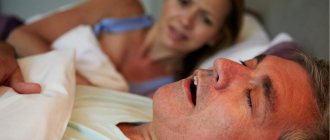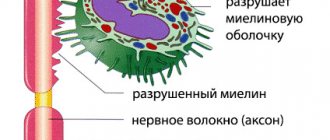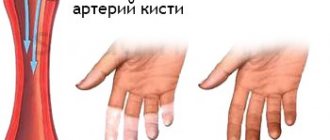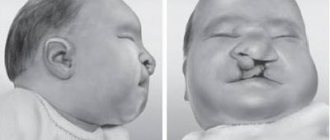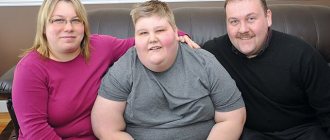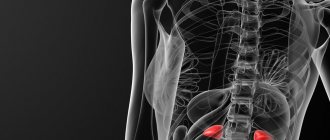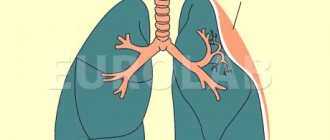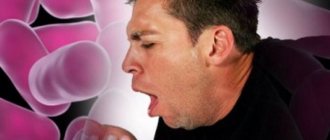Shereshevsky-Turner syndrome is a genetically determined anomaly characterized by impaired psychophysical status, underdevelopment of the genitals and short stature . This congenital disorder develops in girls who have one sex X chromosome instead of two. The typical karyotype of a sick person is 45X0, but other options are also found. The child is usually born prematurely with a number of dangerous abnormalities. Partial or complete X-monosomy leaves an imprint on the entire future life of sick children.
The syndrome is manifested by underdevelopment of secondary sexual characteristics, mammary glands, hypogonadism, and the presence of anomalies of internal organs. Patients often have complete absence of ovaries and menstruation, hair grows on the chest and face, congenital pathologies of the kidneys, heart and blood vessels, joint contractures, skin folds on a short neck, and swollen limbs are detected. Patients lag behind their peers in motor and sexual development. The appearance of adult women is distinguished by coarse facial features, hair growth along the neck to the very back, wide eyes, deformed ears, X-shaped legs, and short stature.
From an early age, sick children feel that they are different from others and are aware of their inferiority. Girls develop a complex due to small breasts, figure flaws and short stature. But a certain infantilism, which persists even into adulthood, helps patients more easily perceive their shortcomings and endure constant psycho-emotional stress. The right approach to children with Turner syndrome helps them quickly adapt to society, lead a full life, make friends, study, fall in love, and start families. Most of them have no deviations in intellectual development.
Diagnosis of the syndrome is based on characteristic clinical data and the results of cytogenetic analysis. Currently, prenatal diagnosis of the disease is carried out using fetal ultrasound and invasive techniques. Patients are treated with hormonal drugs, surgical restorative and restorative treatment.
The syndrome was discovered at the beginning of the last century by endocrinologist N.A. Shereshevsky, who described the symptoms of congenital hypogonadism in his patients. A few years later, a specialist in the field of endocrinology, Turner, defined the nature of the pathology differently and proved that sexual infantilism is always combined with external manifestations and joint deformities. It is known that for every 3,000 newborns, 1 sick child is born. But these statistics are very conditional, since in the early stages pregnant women often experience miscarriages. The syndrome has an ICD-10 code Q96 and the name “Turner syndrome”.
What is Shereshevsky-Turner syndrome?
Shereshevsky-Turner syndrome (also called Shereshevsky syndrome, Turner syndrome) is a rare chromosomal disorder that affects women. The disorder is characterized by partial or complete loss (monosomy) of one of the second sex chromosomes. Turner syndrome is a highly variable condition and can present differently in each woman.
Affected women can potentially develop a wide variety of symptoms, affecting many different organ systems. Common symptoms include short stature and premature ovarian failure, which can lead to failure to reach puberty. Most women with Turner syndrome are infertile. A variety of additional symptoms may occur, including eye and ear abnormalities, skeletal malformations, and heart and kidney disease. Intelligence is usually normal, but affected people may have some learning disabilities.
Shereshevsky-Turner syndrome may be diagnosed before birth or shortly after birth or in early childhood. However, in some cases the disorder may not be diagnosed until adulthood, often by chance. In most cases, this disease does not run in families and occurs randomly for no apparent reason (sporadic).
Shereshevsky-Turner syndrome is one of the most common chromosomal disorders and probably the most common genetic disorder in women.
Pathological anatomy
In Turner syndrome, the gonads are usually undifferentiated connective tissue cords that do not contain gonadal elements. Less common are ovarian rudiments (see), including ovarian stroma, and sometimes individual primordial follicles. The latter can be observed in patients with a karyotype of 45.X/46.XX; 45.X/47.XXX. With a karyotype of 45,X/46,XY, testicular elements can be found in the gonadal cords (see Testicle) - tubules, Leydig cells (interstitial endocrinocytes) and Sertoli cells (supporting cells) and rudiments of the vas deferens (see).
Other pathological data correspond to the characteristics of the wedge, manifestations. The most important changes in the osteoarticular system are vertebral concrescence (see Spine), spina bifida (see), joint deformation (see), shortening of the metacarpal and metatarsal bones, phalanges (see Hand, Foot), osteoporosis (see) etc., changes in the heart (see) and large vessels - coarctation of the aorta (see), patent ductus arteriosus (see Ductus Arteriosus), interventricular septum, stenosis of the aortic mouth, renal arteries, etc., renal malformations (see. ) - horseshoe kidney, doubling of the pelvis and ureters, etc.
Symptoms and signs
The symptoms and severity of Shereshevsky syndrome can vary from one person to another. Many signs of the disorder are nonspecific, and others may develop slowly or may not be noticeable. It is important to note that affected people may not have all of the symptoms described below. Affected families should talk with doctors about their specific case, associated symptoms, and overall prognosis.
Skin fold on the neck.
The anomaly is considered one of the most common manifestations of the syndrome (in 70% of cases). It looks like a wing-shaped seal that runs from the back of the head to the trapezius muscles.
With a significant excess of skin, a visible membrane appears, stretched between the head and shoulders. Such a cosmetic defect can be corrected with a simple operation.
Small growth.
In newborns with a genetic disorder, body length varies between 42-45 cm. However, with the mosaic form of the syndrome, growth may be normal. Development occurs with a lag according to the female type.
Sometimes short stature is caused by a disorder in the formation of the spinal column (vertebral fusion or deformity).
"The Face of the Sphinx"
The symptom can also occur in other diseases, but in Shereshevsky-Turner syndrome it is diagnosed in 35% of cases and is supplemented by cervical skin pathology.
The person has thickened lips (see photo), and there are no natural folds in the forehead area (“polished forehead”). It is difficult for him to close his eyelids completely. Facial expressions are usually difficult (due to congenital weakness of the facial muscles).
Barrel-shaped or flattened chest.
In the first case, the frontal and anteroposterior dimensions of the chest are almost the same. Deformation occurs in 45% of cases of anomaly.
If there is a defect in the formation of the bones of the chest, its flattening is noted.
With moderately severe pathologies of the development of the skeletal system, the sign may become less noticeable with age. The violation cannot be corrected surgically. Usually such influence is not necessary. The defect does not cause changes in the functioning of the heart or respiratory system.
Swelling.
Edema is usually localized in the area of the feet or legs and is considered a specific symptom (occurs with varying degrees of severity in more than 50% of patients). Nails look squeezed. In the presence of congenital malformations, swelling can be very severe.
Poor weight gain.
The weight of newborn babies with Turner syndrome ranges from 2500–2800 g, falling within the normal range. But as the baby grows, body weight gain deviates from optimal values. In the future, he will always be worse than his peers.
Establishing a diagnosis
In an infant, Shereshevsky syndrome can be detected by a neonatologist or pediatrician; a visual examination is sufficient. Indicates the presence of pathology: pterygoid folds on the neck and swollen limbs. If there are no obvious external symptoms, then the disease is detected in adolescence by short stature and the absence of the first menstrual bleeding. In addition, the patient has weakly expressed secondary sexual characteristics.
Diagnosis necessarily includes a hormone analysis. During the study, an increase in the amount of gonadotropins and a decrease in estrogen levels are detected. The study of karyotype is also of great diagnostic importance. The doctor can detect specific signs of pathology after an obstetric ultrasound. If STS is suspected, prenatal diagnosis is prescribed:
- An ultrasound of the fetus shows that the nasal bone is missing, the thickness of the collar space is increased, the femur or humerus are not long enough, etc. A comprehensive study includes the biochemistry of the mother’s blood for β-hCG, PAPP-A.
- Invasive studies (amniocentesis, chorionic villus sampling) are more accurate than the screening described above. A puncture of the amniotic membrane (amniocentesis) and a chorionic villus biopsy (the embryonic part of the placenta) are most often prescribed in case of an increased risk of having a child with STS, in women over 35 years of age, as well as in case of poor results of non-invasive studies.
Invasive studies are carried out only for special indications; they are able to accurately determine pathology.
The patient may need the help of various specialists: geneticist, endocrinologist, cardiologist, nephrologist, ophthalmologist, ENT doctor, gynecologist, andrologist, etc.
To detect congenital defects and concomitant diseases, the following studies are prescribed:
- Echocardiography.
- MRI of the heart.
- Electrocardiogram.
- Ultrasound of the kidneys.
- X-ray of the spinal column, joints of the limbs and the rest of the skeleton.
- Densitometry to check bone density.
- Gynecological examinations.
- Ultrasound of the pelvic organs, scrotum, etc.
To distinguish STS from pituitary dwarfism (delayed physical development due to a lack of growth hormone), it is necessary to conduct an analysis of pituitary hormones, an X-ray of the sella turcica (a formation in the sphenoid bone of the skull), and an EEG (electroencephalography).
Causes
Shereshevsky-Turner syndrome is caused by partial or complete loss (monosomy) of the second sex chromosome. Chromosomes are found in the nucleus of all cells in the body. They carry the genetic characteristics of each person and come in pairs. We receive one copy from each parent. Chromosomes are numbered 1 to 22; The 23rd pair usually consists of one X and one Y chromosome for males and two X chromosomes for females. Thus, women with a normal chromosomal structure (karyotype) have 46 chromosomes, including two X chromosomes (46, XX karyotype). Each chromosome has a short arm, designated "p", and a long arm, designated "q". The chromosomes are further divided into many numbered bands.
Women with Turner syndrome are missing all or part of the second sex chromosome. The reason why this occurs is unknown and is believed to be the result of a random event. In some cases, the chromosomal abnormality appears to occur spontaneously due to an error in the division of the parent's reproductive cells, either in the father's sperm or in the mother's egg. This leads to the fact that the genetic error appears in all cells of the body.
Etiopathogenetic factors
Shershevsky-Turner syndrome is a hereditary pathology caused by the absence of a sex chromosome, which, one might say, finally makes a woman out of a woman. Incorrect cell division during the process of conception leads to the formation of genetic material with obvious disturbances. This chromosomal imbalance is caused by incorrectly “positioned” DNA molecules.
The disease also develops as a result of improper formation of the X chromosome. The reasons for its anomalous structure are:
- loss of a section of a chromosome as a result of its breakage,
- transferred a section of chromosome,
- formation of a chromosome in the form of a ring,
- other chromosomal rearrangements - mutations or aberrations.
Mosaicism is of great importance in the development of the disease. In patients, genetically heterogeneous cells in various variations are found in the tissues. All these options are typical for women. In men, the syndrome occurs extremely rarely. Its main causes are translocation or mosaicism. Meiotic chromosome segregation underlies the pathological process.
An incorrect chromosomal “assembly” may consist in the presence of a Y-chromosomal element in the karyotype. Such patients have their ovaries removed. This is a necessary measure to prolong the life of people with this disease, since the Y-chromosomal element often provokes the development of a cancerous tumor - gonadoblastoma.
Karyotypes for this syndrome:
- Karyotype 45X0 - replacement of glandular tissue of the ovary with connective tissue cords. Non-functioning female glands lead to irreversible infertility. To procreate, they resort to IVF. This type of syndrome is the most common and one of the most severe. It is characterized by pronounced symptoms and the development of severe complications. The syndrome is difficult to treat.
- Mosaic karyotype 45 X0/46 XY – absence of the uterus and underdevelopment of the vagina, high risk of oncology. To prevent recurrence of the disease, removal of the ovaries is indicated. Mosaic karyotype 45 X0/46 XX - negligible size of the ovaries. Pregnancy is possible with the participation of a donor egg. The mosaic type of syndrome has a milder course: no developmental defects are observed, there are much fewer symptoms and they are less pronounced. The disease is well treated. The mosaic type is distinguished by a combination of two types of cells - with a normal karyotype and without one X chromosome. The woman’s health status will depend on their proportionality.
Scientists have now established that the syndrome occurs spontaneously. Age, heredity, lifestyle of parents and their bad habits do not have a significant impact on the formation of the anomaly. Perhaps chromosome deformation occurs during fertilization under the influence of pathogenic factors - ionizing or X-ray radiation, gas pollution and environmental pollution, strong electromagnetic influence.
Initially, the embryo develops a normal number of germ cells. During the growth and development of the fetus, they undergo involution. A newborn girl has very few follicles in the ovary or no follicles at all. In addition to ovarian dysfunction, patients develop numerous defects of internal organs during embryogenesis.
Diagnostics
During pregnancy, the syndrome can be suspected during an ultrasound examination. With Shereshevsky-Turner syndrome, some physical abnormalities appear:
- thickening of the collar area;
- cervical hygroma;
- expansion of the renal pelvis and calyces;
- deformation of bones, shape of the head, limbs;
- heart defects;
- oligohydramnios or polyhydramnios.
Thickening of the nuchal translucency and hygroma are noticeable already at the first planned ultrasound. With the mosaic type of pathology, the results of ultrasound diagnostics remain normal.
To clarify the form of the disorder, fetal karyotyping is recommended. The study is carried out from 10 to 12 weeks of pregnancy.
When performing this procedure (under ultrasound control), a special needle (inserted into the uterine cavity through the anterior abdominal wall) or a catheter (through the cervix) is used to collect amniotic fluid (amniocentesis), blood from the umbilical cord vessels (cordocentesis) or a sample of fetal cells (biopsy). chorion).
Forecast, prevention
As mentioned, TTS does not affect life expectancy in most cases. The risk of death is increased with congenital heart defects and severe concomitant diseases.
With timely, competent and regular treatment, patients will experience maximum height increase (up to 155 cm). After treatment with hormonal drugs, girls have a chance to create their own family, they lead a normal sex life, but many of them remain infertile.
Since patients' brain activity is usually not impaired, they can perform mental work. However, patients are advised to avoid heavy physical activity and professions associated with great neuropsychic stress.
The only available way to prevent STS is medical genetic consultations and comprehensive prenatal diagnostics. The most accurate results are provided by invasive techniques.
Treatment
Treatment for Shereshevsky-Turner syndrome targets the specific symptoms that occur in each person. Treatment may require the coordinated efforts of a team of specialists. Pediatricians, pediatric specialists, surgeons, cardiologists, endocrinologists, speech therapists, otolaryngologists, ophthalmologists, psychologists, and other health care providers may need to plan systematically and comprehensively for a child's affective treatment. Genetic counseling is recommended for affected individuals and their families.
conclusions
Genetic diseases are rare, but their feature is a combination of pathologies of various organs and systems and characteristic external manifestations. There are many reasons for the development of mutations in the genotype, and it is not always possible to detect the factor that influenced the appearance of abnormalities in the child. No family is immune from the birth of a baby with a genetic defect.
Parents of a child with Shereshevsky-Turner syndrome need to understand that correct, timely treatment significantly improves the child’s quality of life and reduces the severity of the main symptoms. In general, the prognosis for this disease is favorable; children with a genetic defect are able to socialize in society, receive higher education, and live a long life.
Forecast
The prognosis for Turner syndrome is favorable in terms of life expectancy and intellectual development. The exception is when:
- congenital heart defects;
- spina bifida;
- abnormal formation of the genitourinary system.
As for the restoration of reproductive function, most patients remain infertile. However, with adequate and timely therapy, women can create families, lead a full sex life, and give birth to children.
Shereshevsky-Turner syndrome is a complex genetic pathology that affects the entire body. However, with timely diagnosis and proper treatment, patients have a chance to adapt to society.
Etiology
The main reason for the formation of Shereshevsky-Turner syndrome is a violation of the normal karyotype, in which there is an absence of the second sex chromosome. The mechanism of transmission of the disease is not fully understood. There is a lot of controversy in the medical field about its heredity. Predisposing factors for the onset of the disease are:
- various infections of the reproductive system previously suffered by the expectant mother;
- unfavorable environmental conditions, gas contamination, pollution;
- a woman's consumption of large quantities of alcohol during pregnancy;
- strong electromagnetic or ionizing radiation;
- fasting or any other depletion of the body, for example, during a serious illness (often in the period before conception).
In most cases, the appearance of the syndrome is observed accidentally - often such children are born to absolutely healthy parents. This means that it is impossible to predict the conception of a sick child or to take preventive measures in advance. During pregnancy, you can find out about the disease only through a karyotype analysis.
List of sources
- Dedov I.I., Peterkova V.A., Semicheva T.V., Volevodz N.N. Shereshevsky-Turner syndrome. - M., 2002;
- Kravets E.B. Clinical lectures on pediatric endocrinology. - Tomsk, Ex Libris, 2007;
- Peterkova V.A., Bezlepkina O.B., Semicheva T.V., Koledova E.B. Shereshevsky-Turner syndrome in children (clinic, diagnosis, treatment). Guidelines. M., 1998;
- Dedov I.I., Peterkova V.A. Pediatric endocrinology. Guide to pediatric endocrinology. - M., Universum Publishing, 2006;
- Pankratova, M.S. Shereshevsky-Turner syndrome in the practice of a pediatric endocrinologist / Pankratova M.S., Peterkova V.A. //Pediatrics. - 2009. - No. 4. - P. 115-121.
